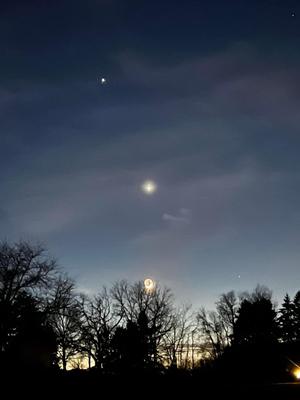Glossary term: Conjonction
Description: Du point de vue d'un observateur sur Terre, lorsque deux objets astronomiques semblent se trouver à proximité dans le ciel, on dit qu'ils sont en conjonction. Il n'est pas nécessaire que la conjonction soit réellement visible - par exemple, la Lune et le Soleil sont approximativement alignés chaque fois qu'il y a une nouvelle Lune, mais nous ne pouvons pas voir la Lune dans ces conditions, à moins qu'il n'y ait une éclipse solaire. Dans ce cas, et lorsqu'une conjonction est si proche qu'un objet semble recouvrir l'autre, les astronomes parlent de transit ou d'éclipse.
Related Terms:
See this term in other languages
Term and definition status: The original definition of this term in English have been approved by a research astronomer and a teacher The translation of this term and its definition have been approved by a research astronomer and a teacher
The OAE Multilingual Glossary is a project of the IAU Office of Astronomy for Education (OAE) in collaboration with the IAU Office of Astronomy Outreach (OAO). The terms and definitions were chosen, written and reviewed by a collective effort from the OAE, the OAE Centers and Nodes, the OAE National Astronomy Education Coordinators (NAECs) and other volunteers. You can find a full list of credits here. All glossary terms and their definitions are released under a Creative Commons CC BY-4.0 license and should be credited to "IAU OAE".
If you notice a factual or translation error in this glossary term or definition then please get in touch.
Related Media
Jupiter, Venus, Moon Conjunction
Credit: Joslynn Appel/IAU OAE (CC BY 4.0)
License: CC-BY-4.0 Creative Commons Attribution 4.0 International (CC BY 4.0) icons
Moon-Mercury-Pleiades Conjunction
Credit: Giulio Colombo/ IAU OAE
License: CC-BY-4.0 Creative Commons Attribution 4.0 International (CC BY 4.0) icons










